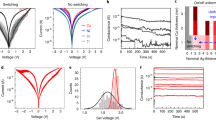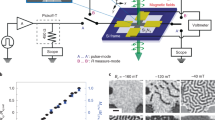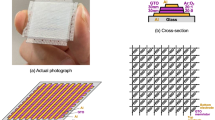Abstract
Although several types of architecture combining memory cells and transistors have been used to demonstrate artificial synaptic arrays, they usually present limited scalability and high power consumption. Transistor-free analog switching devices may overcome these limitations, yet the typical switching process they rely on—formation of filaments in an amorphous medium—is not easily controlled and hence hampers the spatial and temporal reproducibility of the performance. Here, we demonstrate analog resistive switching devices that possess desired characteristics for neuromorphic computing networks with minimal performance variations using a single-crystalline SiGe layer epitaxially grown on Si as a switching medium. Such epitaxial random access memories utilize threading dislocations in SiGe to confine metal filaments in a defined, one-dimensional channel. This confinement results in drastically enhanced switching uniformity and long retention/high endurance with a high analog on/off ratio. Simulations using the MNIST handwritten recognition data set prove that epitaxial random access memories can operate with an online learning accuracy of 95.1%.
This is a preview of subscription content, access via your institution
Access options
Access Nature and 54 other Nature Portfolio journals
Get Nature+, our best-value online-access subscription
24,99 € / 30 days
cancel any time
Subscribe to this journal
Receive 12 print issues and online access
We are sorry, but there is no personal subscription option available for your country.
Buy this article
- Purchase on SpringerLink
- Instant access to full article PDF
Prices may be subject to local taxes which are calculated during checkout




Similar content being viewed by others
References
Jo, S. H. et al. Nanoscale memristor device as synapse in neuromorphic systems. Nano Lett. 10, 1297–1301 (2010).
Burgt, Y. et al. A non-volatile organic electrochemical device as a low-voltage artificial synapse for neuromorphic computing. Nat. Mater. 16, 414–418 (2017).
Burr, G. W. et al. Experimental demonstration and tolerancing of a large-scale neural network (165,000 synapses), using phase-change memory as the synaptic weight element. In 2014 IEEE Int. Electron Devices Meeting 29.5.1-29.5.4 (IEEE, 2014).
Wang, Z. et al. Memristors with diffusive dynamics as synaptic emulators for neuromorphic computing. Nat. Mater. 16, 101–108 (2016).
Kim, S. et al. Experimental demonstration of a second-order memristor and its ability to biorealistically implement synaptic plasticity. Nano Lett. 15, 2203–2211 (2015).
Lee, M.-J. et al. A fast, high-endurance and scalable non-volatile memory device made from asymmetric Ta2O5−x/TaO2−x bilayer structures. Nat. Mater. 10, 625–630 (2011).
Gokmen, T. & Vlasov, Y. Acceleration of deep neural network training with resistive cross-point devices: Design considerations. Front. Neurosci. 10, 333 (2016).
Shibuya, K., Dittmann, R., Mi, S. & Waser, R. Impact of defect distribution on resistive switching characteristics of Sr2TiO4 thin films. Adv. Mater. 22, 411–414 (2010).
Park, G.-S. et al. In situ observation of filamentary conducting channels in an asymmetric Ta2O5−x/TaO2−x bilayer structure. Nat. Commun. 4, 495707 (2013).
Yu, S., Guan, X. & Wong, H.-S. P. Conduction mechanism of TiN∕HfO x ∕Pt resistive switching memory: A trap-assisted-tunneling model. Appl. Phys. Lett. 99, 063507 (2011).
Strukov, D. B., Snider, G. S., Stewart, D. R. & Williams, R. S. The missing memristor found. Nature 453, 80–83 (2008).
Szot, K., Speier, W., Bihlmayer, G. & Waser, R. Switching the electrical resistance of individual dislocations in single-crystalline SrTiO3. Nat. Mater. 5, 312–320 (2006).
Kim, K.-H. et al. A functional hybrid memristor crossbar-array/CMOS system for data storage and neuromorphic applications. Nano Lett. 12, 389–395 (2012).
Yang, Y. et al. Electrochemical dynamics of nanoscale metallic inclusions in dielectrics. Nat. Commun. 5, 377–383 (2014).
Jo, S. H., Kim, K. H. & Lu, W. High-density crossbar arrays based on a Si memristive system. Nano Lett. 9, 870–874 (2009).
Jo, S. H. & Lu, W. CMOS compatible nanoscale nonvolatile resistance switching memory. Nano Lett. 8, 392–397 (2008).
Waser, R., Dittmann, R., Staikov, G. & Szot, K. Redox-based resistive switching memories - nanoionic mechanisms, prospects, and challenges. Adv. Mater. 21, 2632–2663 (2009).
Yang, Y. et al. Observation of conducting filament growth in nanoscale resistive memories. Nat. Commun. 3, 732 (2012).
Ielmini, D. & Waser, R. Resistive Switching: From Fundamentals of Nanoionic Redox Processes to Memristive Device Applications (Wiley-VCH, Weinheim, Germany, 2016).
Yang, J. J., Strukov, D. B. & Stewart, D. R. Memristive devices for computing. Nat. Nanotechnol. 8, 13–24 (2013).
Krishnan, K., Tsuruoka, T., Mannequin, C. & Aono, M. Mechanism for conducting filament growth in self-assembled polymer thin films for redox-based atomic switches. Adv. Mater. 28, 640–648 (2016).
Alibart, F., Zamanidoost, E. & Strukov, D. B. Pattern classification by memristive crossbar circuits using ex situ and in situ training. Nat. Commun. 4, 2072 (2013).
Speck, J. S., Brewer, M. A., Beltz, G., Romanov, A. E. & Pompe, W. Scaling laws for the reduction of threading dislocation densities in homogeneous buffer layers. J. Appl. Phys. 80, 3808 (1996).
Porter, D. A., Easterling, K. E. & Sherif, M. Y. Phase Transformations in Metals and Alloys (CRC Press, Boca Raton, USA, 2009).
Houghton, D. C. Strain relaxation kinetics in Si1-xGe x /Si heterostructures. J. Appl. Phys. 70, 2136–2151 (1991).
Romanov, A. E., Pompe, W., Beltz, G. & Speck, J. S. Modeling of threading dislocation density reduction in heteroepitaxial layers I. Geometry and crystallography. Phys. Status Solidi 198, 599–613 (1996).
Rollert, F., Stolwijk, N. A. & Mehrer, H. Solubility, diffusion and thermodynamic properties of silver in silicon. J. Phys. D 20, 1148 (1987).
Effenberg, G., Aldinger, F. & Prince, A. Ternary Alloys 211–221 (VCH, Weinheim, Germany, 1988).
Al-Joubori, A. A. & Suryanarayana, C. Synthesis of metastable NiGe2 by mechanical alloying. Mater. Des. 87, 520–526 (2015).
Yu, S. et al. Scaling-up resistive synaptic arrays for neuro-inspired architecture: Challenges and prospect. In 2015 IEEE International Electron Devices Meeting (IEDM) 17.3.1–17.3.4 (INSPEC, London, 2015).
Hull, R. Properties of Crystalline Silicon (Institution of Electrical Engineers, 2006).
Wells, A. F. Structural Inorganic Chemistry (Oxford University Press, New York, USA, 2012).
Schimmel, D. G. Defect etch for <100> silicon evaluation. J. Electrochem. Soc. 126, 479–483 (1979).
Chen, P.-Y., Gao, L. & Yu, S. Design of resistive synaptic array for implementing on-chip sparse learning. IEEE Trans. Multi-Scale Comput. Syst. 2, 257–264 (2016).
Prezioso, M. et al. Training and operation of an integrated neuromorphic network based on metal-oxide memristors. Nature 521, 61–64 (2015).
Lee, J., Du, C., Sun, K., Kioupakis, E. & Lu, W. D. Tuning ionic transport in memristive devices by graphene with engineered nanopores. ACS Nano 10, 3571–3579 (2016).
You, B. K., Byun, M., Kim, S. & Lee, K. J. Self-structured conductive filament nanoheater for chalcogenide phase transition. ACS Nano 9, 6587–6594 (2015).
Liu, Q. et al. Improvement of resistive switching properties in ZrO2-based ReRAM with implanted Ti ions. IEEE Electron Device Lett. 30, 1335–1337 (2009).
Chang, W. Y., Lin, C. A., He, J. H. & Wu, T. B. Resistive switching behaviors of ZnO nanorod layers. Appl. Phys. Lett. 96, 242109 (2010).
Yoon, J. H. et al. Highly improved uniformity in the resistive switching parameters of TiO2 thin films by inserting Ru nanodots. Adv. Mater. 25, 1987–1992 (2013).
Hubara, I., Courbariaux, M., Soudry, D., El-Yaniv, R. & Bengio, Y. Quantized neural networks: training neural networks with low precision weights and activations. Preprint at https://arxiv.org/abs/1609.07061 (2016).
Ambrogio, S., Balatti, S., Choi, S. & Ielmini, D. Impact of the mechanical stress on switching characteristics of electrochemical resistive memory. Adv. Mater. 26, 3885–3892 (2014).
LeCun, Y., Bottou, L., Bengio, Y. & Haffner, P. Gradient-based learning applied to document recognition. Proc. IEEE 86, 2278–2323 (1998).
Kataeva, I., Merrikh-Bayat, F., Zamanidoost, E. & Strukov, D. Efficient training algorithms for neural networks based on memristive crossbar circuits. In Proc. Int. Joint Conf. Neural Networks 1–8 (IEEE, 2015).
Chen, P.-Y., Peng, X.C. & Yu. S. User Manual of MLP Simulator (+NeuroSim) (accessed 1 January 2017); https://github.com/neurosim/MLP_NeuroSim
Chen, P.-Y., Peng, X. & Yu, S. NeuroSim+: An integrated device-to-algorithm framework for benchmarking synaptic devices and array architectures. IEEE Int. Electron Devices Meeting (IEDM) (IEEE, San Francisco, USA, 2017).
Prezioso, M. et al. Modeling and implementation of firing-rate neuromorphic-network classifiers with bilayer Pt/Al2O3/TiO2–x/Pt memristors. In Technical Digest - International Electron Devices Meeting, IEDM, 17.4.1–17.4.4 (IEEE, 2016).
Ortiz-Conde, A. et al. A review of recent MOSFET threshold voltage extraction methods. Microelectron. Reliab. 42, 583–596 (2002).
Gao, L. et al. Fully parallel write/read in resistive synaptic array for accelerating on-chip learning. Nanotechnology 26, 455204 (2015).
Acknowledgements
This work is partially supported by NSF-SRC-E2CDA under contract no. 2018-NC-2762B. We thank J. J. Yang, Q. Xia, P. Lin, Y. Li, M. Rao and Y. Zhuo of the University of Massachusetts for valuable help and fruitful discussion. We also thank S. Kim of the IBM T.J. Watson Research Center for valuable suggestions for experiments. This work was performed in part at the Micro Technology Laboratories (MTL) at the Massachusetts Institute of Technology, and in part at the Harvard University Center for Nanoscale Systems (CNS), supported by the National Science Foundation under NSF ECCS award no. 1541959.
Author information
Authors and Affiliations
Contributions
S.C. and J.K. conceived this work and J.K. directed the team. S.C., S.H.T. and J.K. designed experiments. S.C., S.H.T., Z.L. and J.K. prepared the manuscript. S.H.T. and Y.K. carried out the epitaxial growth experiments and characterization. S.C., S.H.T., C.C. and H.Y. performed the device fabrication and electrical measurements of epiRAM devices and TEM/SEM characterization. Z.L., P.-Y.C. and S.Y. performed the simulation work. All authors discussed and contributed to the discussion and analysis of the results regarding the manuscript at all stages.
Corresponding author
Ethics declarations
Competing interests
The authors declare no competing financial interests.
Additional information
Publisher’s note: Springer Nature remains neutral with regard to jurisdictional claims in published maps and institutional affiliations.
Supplementary information
Supplementary Information
Supplementary Figures 1–21.
Rights and permissions
About this article
Cite this article
Choi, S., Tan, S.H., Li, Z. et al. SiGe epitaxial memory for neuromorphic computing with reproducible high performance based on engineered dislocations. Nature Mater 17, 335–340 (2018). https://doi.org/10.1038/s41563-017-0001-5
Received:
Accepted:
Published:
Issue Date:
DOI: https://doi.org/10.1038/s41563-017-0001-5



